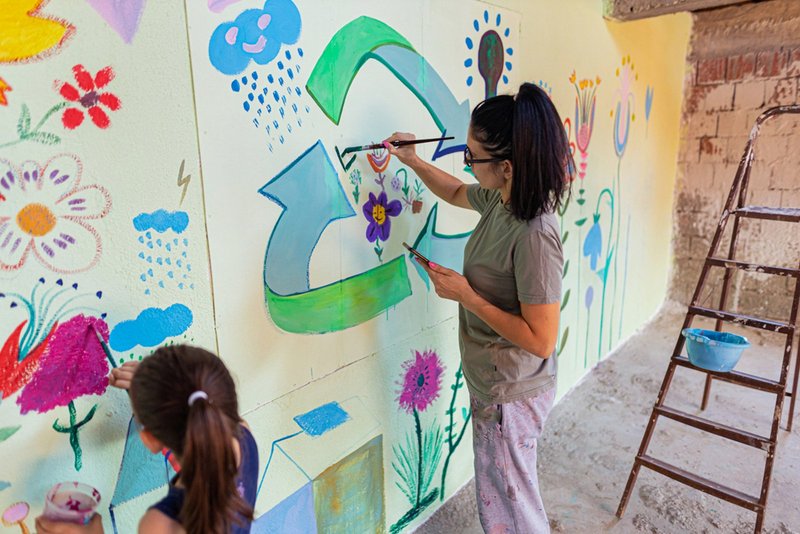
“Fix it, dad!“
Toys also have a right to be repaired
By Peter Thomas
Don’t replace it – repair it: This trend is now even being impowered by legal requirements.
The computer scientist Hans-Joachim Simon is a pioneer in the movement with his toy repair service.
A truly sustainable handling of toys takes time. The longer a toy is used, the better is its overall environmental impact. If something breaks, small repairs are usually enough to restore a toy to its former functionality. “However, in our society children’s toys are often considered to be disposable products,” says Hans-Joachim Simon, “and this is a very, very sad development”.

But the 62-year-old computer scientist did not want to simply accept that mentality. When his own children were small and enthusiastically played with a model train set made by the Lego brand Duplo, the environmentally conscious father would buy additional tracks and rolling stock for the quickly growing layout at flea markets. However, some locomotives turned out to be defective. “Yet the classical toy train is actually quite robust. So I noticed that the locomotives would be easy to repair, but that there are only very few replacement parts,” Simon remembers today.
Getting a large model railway layout via repairs
Giving up was not an alternative for the passionate tinkerer. When he was only eight years old, he tried his patience on a computer. As a teenager, he repaired calculators. Before studying computer science, he completed an apprenticeship as an electronics technician with the German Navy. So, he analysed which technical problems happened the most often – for example broken cogwheels – and set about finding solutions. The whole family got to reap the benefits: “Half a year after I started doing repairs, the kids had a huge train layout in the attic on which up to 14 trains would make their rounds,” Simon says enthusiastically.

His children’s successful plea of “Fix it, dad!” (Papa, mach ganz!) turned into his own sustainable business model under the same name: For about ten years, Simon has been repairing children’s toys on behalf of customers. His focus remains on toy trains by various manufacturers such as Lego, Playmobil, and Brio. The hub for this is his website www.papa-mach-ganz.de, on which Simon offers repairs at fixed prices, replacement parts, and repair instructions.
Repair culture
What matters most to the computer technician and mechanics-aficionado is that the repair is both technically successful and also makes playing safely possible again. “It is not my goal to reproduce a condition close to the original suitable for displays, but rather to make a children’s toy functional again for several years – I am really just a repairman, not a restorer.”
Simon would like to see a repair culture emerge. For that to happen, a mindset change is not only necessary from manufacturers, but also from consumers. The Bonn native is not alone in this philosophy. The trend of so-called repair cafés, in which experienced tinkerers help other people repair technical gadgets, underlines this. The consumer advice centre of North Rhine-Westphalia referred to over 850 such cafés in Germany alone in a report in 2021. The movement started in the Netherlands in the late 2000s.
In the meantime, legislation has also acknowledged the necessity of prolonging the life cycle of products via repairability. The so-called “right to repair” has been applicable especially to electrical and electronic household appliances in Germany since last year.
Networking
At the heart of the legislation is the requirement for manufacturers to have spare parts in stock for longer periods of time. Hans-Joachim Simon knows just how important that is: “Finding the parts is often a problem when repairing,” he says. That is why he has built up a network over the past years, including a manufacturer of brass pinions in Thuringia.
But what if his customers prefer to take things into their own hands according to the motto ‘self-reliance is the name of the game’ instead of commissioning repairs with him? Then, Simon is glad that he has encouraged people to do so through his work. He even helps them out with relevant repair guides: “They have to be both detailed and comprehensible”, he explains. Simon knows these requirements from his career as an IT expert, in which he would compile technical documentations, among other things.
“Developments such as the ‘right to repair’ are good and important”, says Simon, “but consumers have to make use of the opportunity and make demands”. Furthermore, the toy-buying mindset change must also include moving away from exclusively looking at the price over to paying attention to quality. And quality usually goes hand in hand with repairability.
About the author
Telling stories about technology and people: This has fascinated the journalist, author, cultural scientist and lecturer for more than 30 years. Technical toys are always in focus, from construction kits to interactive digital educational toys. After studying and working as a research assistant at university, Peter Thomas writes for daily newspapers, magazines and corporate publications in German and English-speaking countries. In addition to the world of games, his focus is on mobility, security, energy and medical technology.




